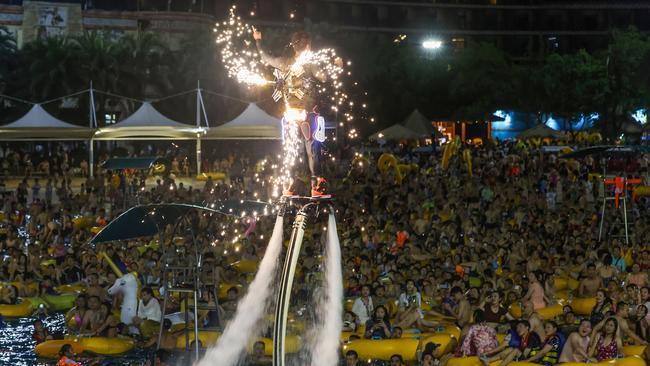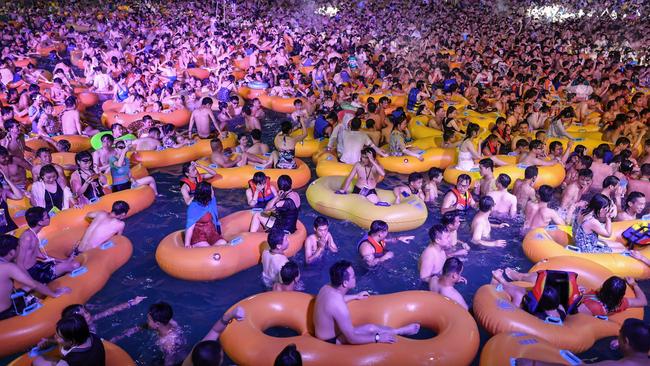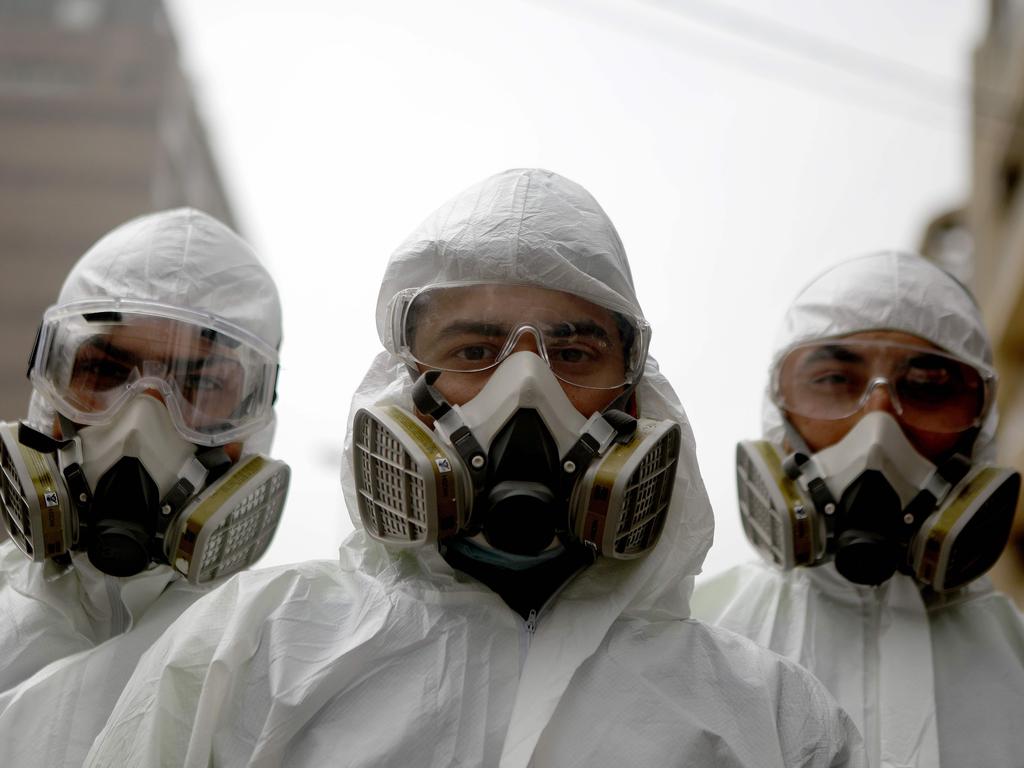China shakes off season of doom
In Wuhan, ground zero of the pandemic wreaking havoc across the globe, life is almost back to normal. How are they doing it?

Not all of China’s 1.4 billion people are spending the COVID summer of 2020 floating on inflatable pool toys in Wuhan, bopping to techno K-pop while watching dancing girls in bright tutus.
In Beijing, hundreds packed together last weekend in one of the capital’s ritziest neighbourhoods for the Hot & Spicy Festival.
There were only slightly more face masks than watermelon halves among the young crowd at the Mexican-themed party who danced to DJ Mario Yu after watching the therapeutic beating of a virus pinata.
Over on China’s northeast coast at Qingdao, the beer mecca of the world’s most populous country, still more gathered for the city’s beer festival.
Aside from the face masks on the bar staff and a sharp reduction in non-Chinese customers, the event dubbed “Asia’s Oktoberfest” looked remarkably similar to past years since it began in 1991, as boisterous attendees skulled beer the day before the developed world’s coronavirus poster child, New Zealand, delayed its election by a month because of an outbreak.
After the worst lunar new year holiday anyone in China can remember, months of home detention and the nastiest economic environment in more than 40 years, people in China have some reason to feel better about life.
“Except for body temperature checks at public venues, you almost can’t feel the restrictions anywhere,” Chang Zhi, a financial officer at a construction company in Beijing, tells The Australian.

By profession a numbers man, Chang reckons his life now is “70 to 80 per cent” back to how it was before the epidemic.
Feeling buoyed, he just bought a new camera to get back to his hobby of photography.
Daily case numbers released by the country’s National Health Commission are now so low they routinely do not make it into state newspapers.
On Friday, the commission said in the previous 24 hours there were no symptomatic cases of COVID-19 and only a single asymptomatic case found domestically across mainland China, home to almost a fifth of the world’s 7.8 billion people.
Another 22 cases were found in the country’s government-run hotel quarantine program where, unlike at Victoria’s shuttered program, COVID-19 testing is compulsory.
The US, with a population less than a quarter the size of China, found more than 40,000 new cases on the same day. The daily COVID-19 death toll in America was over 1300. It was zero in China.
Not that the world’s second biggest economy has quite moved into a post-pandemic world. Coexisting with the summer parties is an ongoing alertness. Face masks remain compulsory on public transport and something like four-fifths of people in China still wear them when they leave their homes.
“Listen to the government’s advice. Stay cautious. And try to avoid crowds if possible,” Beijing fashion designer Cheng Xiaowie, 22, says. “There are things out of your own control, but at least we can control ourselves.”
Underpinning China’s COVID summer is a coronavirus control system built on a scale dwarfing any other in the world.
Not much of it is terribly futuristic, but its reach is remarkable.
Three months before 3000 people in Wuhan squeezed together for last weekend’s music festival at Happy Valley amusement park, almost the entire city’s population — about 10 million people — were tested for COVID-19 in just over a fortnight.
That was after the central Chinese city’s residents endured a 76-day lockdown of a severity far beyond what Melbourne is going through.
Their sense of safety has been long earned, as Happy Valley’s deputy general manager, Tang Haifeng, pointed out in an interview with state media published after videos of the Wuhan party went viral outside China.
“We are getting back to normal life, and the city is becoming better and better,” Tang said, adding that Wuhan had not had a single new COVID-19 case since mid-May.
All visitors who entered Happy Valley at the weekend had to show a health code on their phones. No green code showing their health status, no entry.
These simple health programs — embedded in China’s ubiquitous social media platform WeChat — are required for entry into cafes, bars, restaurants and, crucially, to travel around the country.
They are linked to people’s home addresses and change colour from green to yellow or red if people visit an area deemed high risk — which in mainland China right now is an area with any domestic outbreak at all.
The set up makes the Chinese equivalent of a surreptitious Brisbane-to-Melbourne jaunt via Sydney all but impossible. The code can’t lie.
On top of that is an eradication strategy that scales up with extraordinary speed. When new outbreaks occur, they are quashed with thumping state power.
The response to an outbreak in Beijing in mid-June linked to the capital’s enormous Xinfadi wholesale food market demonstrated the system’s heft.
Chang Zhi, the photography-loving financial officer, experienced it first-hand.
Days after the first case was confirmed at Xinfadi he received a text on his mobile: “We noticed from your mobile tracking system that you drove by Xinfadi wholesale market yesterday. Please go to a nearby hospital to have the test.”
A targeted lockdown on a Melbourne-sized portion of the city of 21 million was imposed. Over the next two weeks, more than 11 million people were given nucleic acid tests, according to officials at Beijing’s Centre for Disease Control and Prevention.
The city’s officials announced the transmission chain was cut after 12 days. They reported a total of 335 cases from the spread — less than half the daily peak of Melbourne’s outbreak, which by contrast is now at least three months old and is still smouldering.
Not that it wasn’t clumsy at times.
After his first text, Chang received another three — each requesting he get another COVID-19 test. His commute to work, by himself in his car, was taking him through an area deemed “high risk” by Beijing’s surveillance system.
“How can I not pass the market? I have to drive past it every day to work,” Chang told his doctor.
Many in America, including President Donald Trump, have expressed suspicion in the numbers released by a health body controlled by the Chinese Communist Party.
That China’s National Health Commission has changed the definition of a confirmed COVID-19 case has complicated international comparisons. For months it excluded asymptomatic cases and now it records them separately, unlike in the US or Australia.
But the thousands of revellers at Wuhan’s Happy Valley, Beijing’s Hot & Spicy Festival and Qingdao’s International Beer Festival seem to believe the numbers are not far off.
Chinese intellectuals, even some who are critical of President Xi Jinping’s regime, see historic significance in the relative performance of the 20th century’s dominant superpower and its 21st century rival.
In a recent essay Deng Yuwen, a political commentator critical of China’s current nationalism, argues the US’s much higher infection and death rates have reinforced the narrative of exceptionalism promoted by Chinese officials.
“(It) diminished the aura of American democracy in the eyes of the Chinese people,” Deng argues.
It has also diminished the American economy, which the International Monetary Fund forecasts will shrink by 8 per cent this year.
By contrast, China is the world’s only major economy on track for growth, albeit modestly by its own standards, at 1 per cent.
Awful memories of the People’s War still shadow China’s COVID summer.
Only months ago, stern red banners were hung around the country, including one in Hanchuan, a city about an hour’s drive from Wuhan’s Happy Valley, that warned: “If you step out of home, we break your legs; if you argue with us, we break your teeth.”
Many in China, such as Beijing-based graphic artist Xie Hao, 24, say they are still shaken up.
“It was a really difficult period for me. I don’t know how I survived. It’s a period I don’t want to look back on,” Xie says.








To join the conversation, please log in. Don't have an account? Register
Join the conversation, you are commenting as Logout